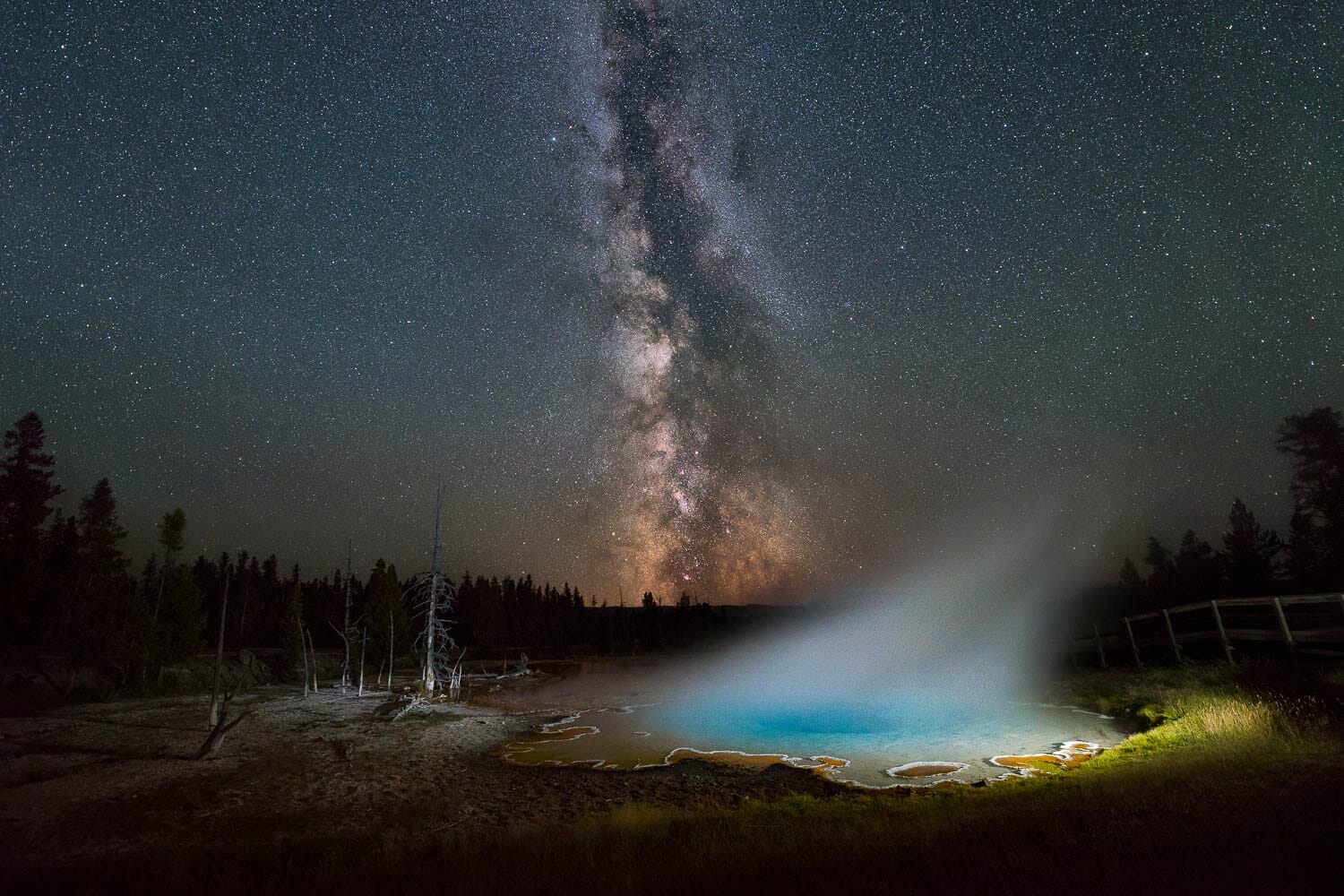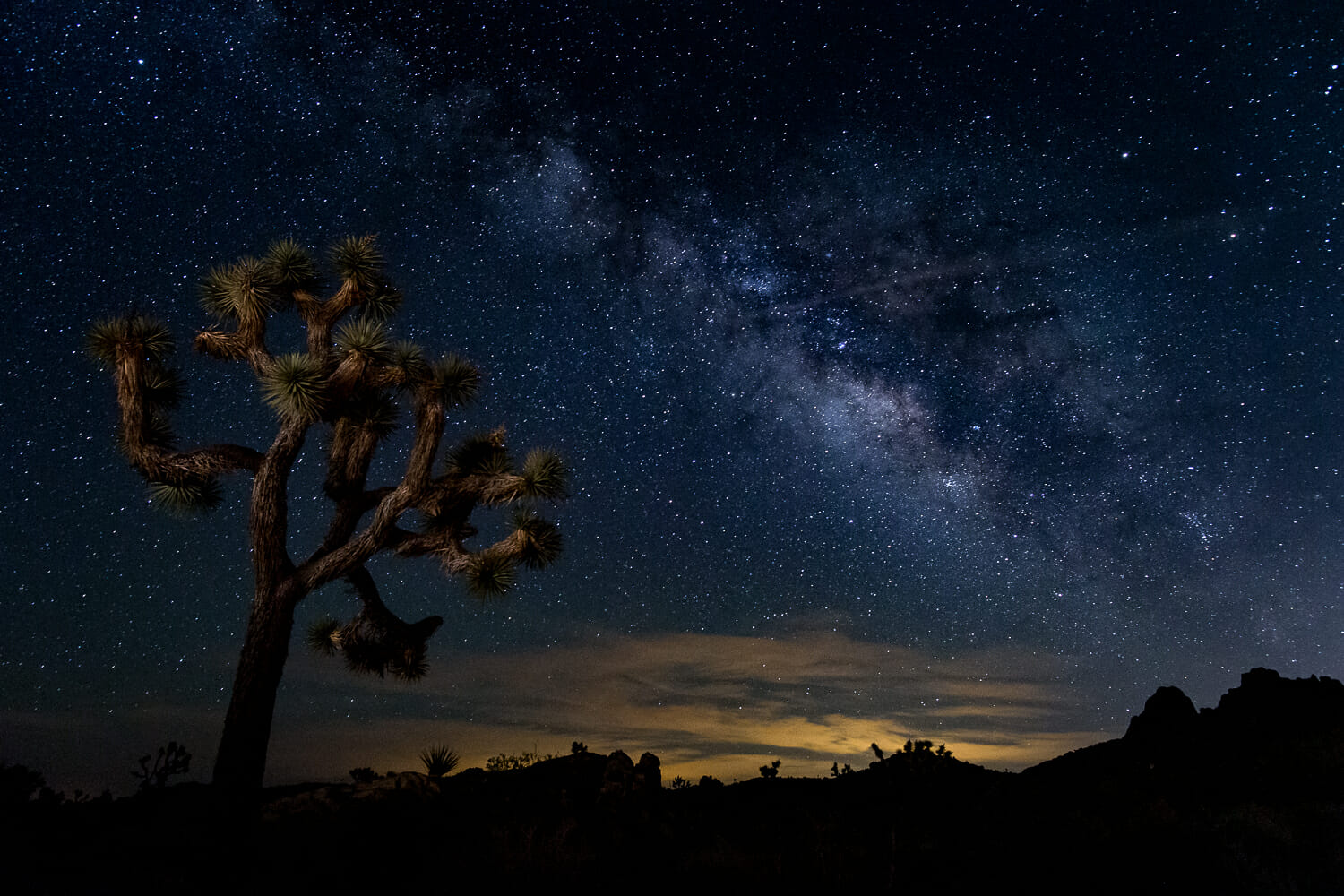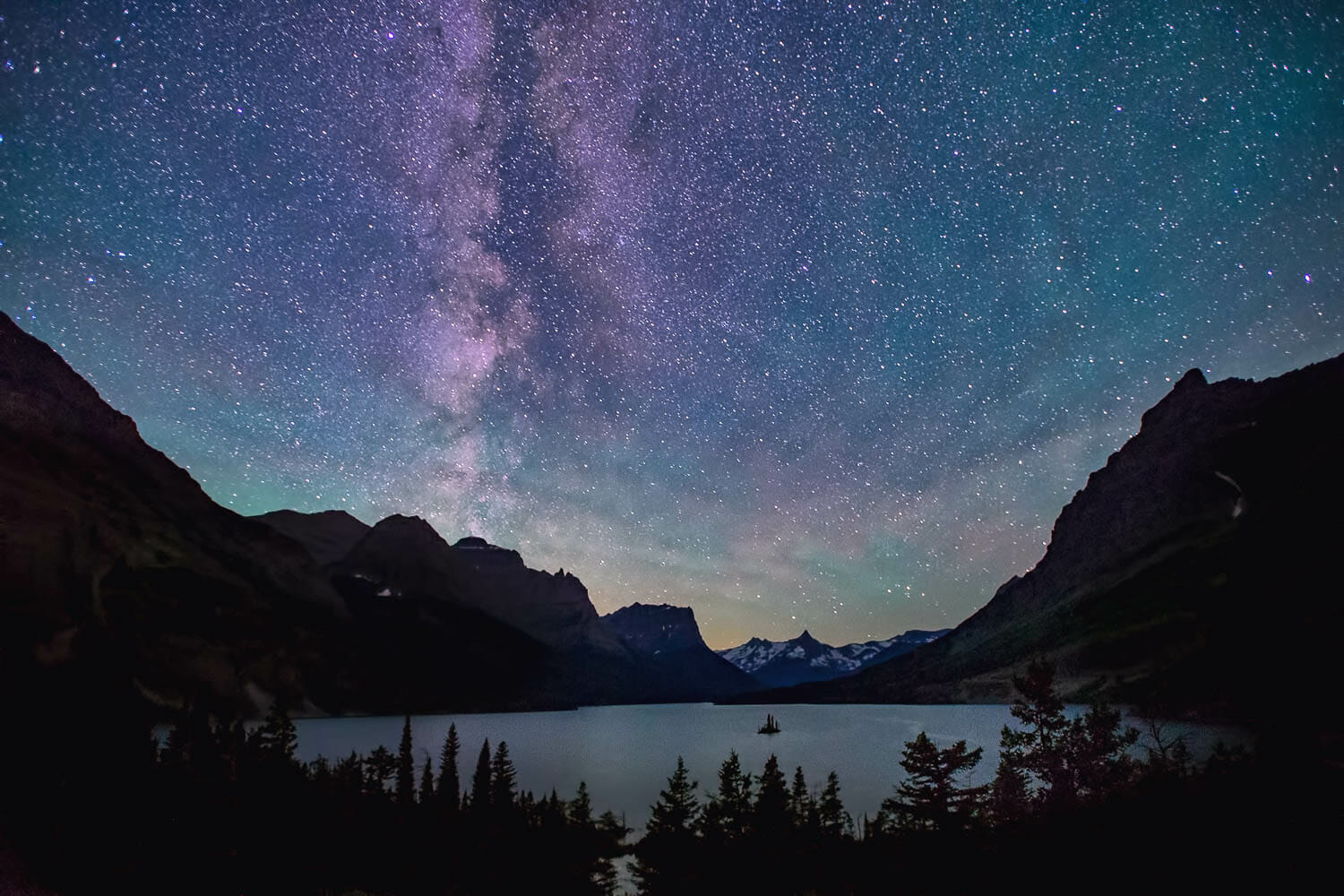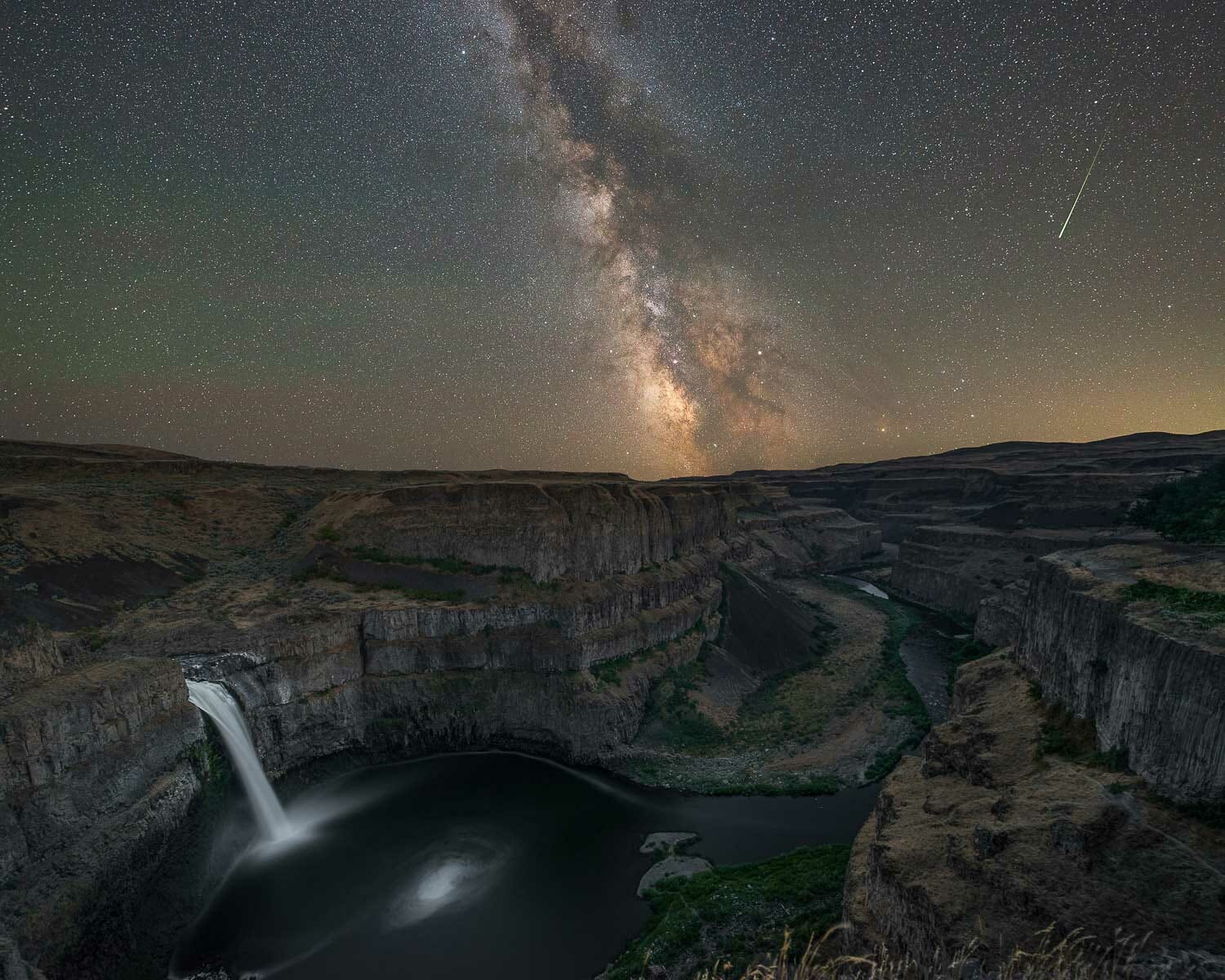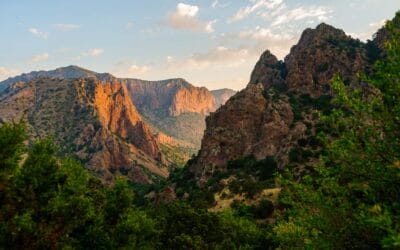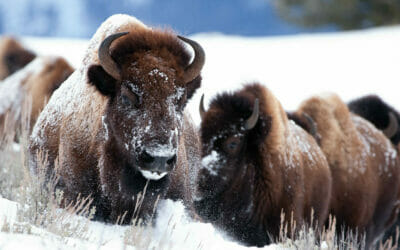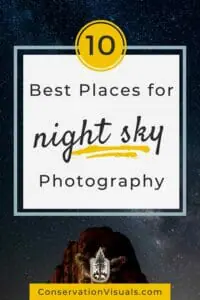Contents
- What is astrophotography?
- Death Valley National Park
- Cape Lookout National Seashore
- Big Bend National Park
- Mammoth Cave National Park
- Joshua Tree National Park
- Grand Canyon National Park
- Glacier National Park
- Sedona Red Rocks
- Great Basin National Park
- Great Sand Dunes National Park
- How to find more locations
- Tips for safe stargazing
Feature photo by Arthur Cauty/Shutterstock
Read Time: 9 minutes
Astrophotography and night sky photography aren't just about capturing captivating images of the celestial world above. They're an entire journey, an immersive experience with the potential to showcase some of the most awe-inspiring landscapes imaginable.
Even after generations of explorers and scientists have charted the cosmos and studied the stars, there is still something indescribably magical and humbling about venturing out under the stars and capturing their secrets on camera.
But, to do this, you need to have the right location.
To help you in your quest, this article covers our favorite locations in the US for capturing spellbinding images of the night sky.
Contents
- What is astrophotography? Is it different from night sky photography?
- Death Valley National Park, California
- Cape Lookout National Seashore, North Carolina
- Big Bend National Park, Texas
- Mammoth Cave National Park, Kentucky
- Joshua Tree National Park, California
- Grand Canyon National Park, Arizona
- Glacier National Park, Montana
- Sedona Red Rocks, Arizona
- Great Basin National Park, Nevada
- Great Sand Dunes National Park, Colorado
- How to find more amazing dark-sky locations
- Tips for safe and responsible stargazing
From the inky blackness over Great Basin National Park to the ethereal Aurora Borealis over Glacier National Park, these spots offer unique opportunities to witness the night sky in its full, breathtaking glory and capture images that will take your (and your followers') breath away.
Now, let's get ready to discover some of the most stunning night skyscapes that will send you running to pack your photography bag!
What is astrophotography? Is it different from night sky photography?
A well-captured image of the Milky Way, planets, stars, or galaxies can leave viewers in awe of the cosmos.
Astrophotography is a specialized genre of photography that captures images of the celestial world. On the other hand, night sky photography typically focuses on capturing landscapes with the stars as an essential character in the scene.
While often confused with night sky photography, astrophotography is more intricate and involves capturing celestial objects in vivid detail. Astrophotography also requires specialized equipment, such as a telescope or telephoto lens.
In contrast, night sky photography can be done with equipment that most photographers already have on hand.
One thing that night sky photography and astrophotography have in common is that the darker the sky, the better the shots!
There are many breathtaking locations across the world offering unrivaled opportunities for capturing stunning celestial images – and some of the best locations are in the United States.
Recommended: Looking for a detailed guide on how to photograph the night sky? Check out Night Sky Photography: The Complete Guide for Beginners where we provide a comprehensive guide on capturing the best shots, including the gear you need, the methods to try, and how to prepare for the shoot.
Best Locations in the US for Astrophotography and Night Sky Photography
Photo: Asif Islam/Shutterstock
The Milky Way dances over Zabriskie Point in Death Valley, where the night sky dazzles and astrophotography dreams come true.
1. Death Valley National Park, California
Nestled in the desolate beauty of the Mojave Desert, Death Valley National Park's remote location and vast stretches of unspoiled land make it an ideal spot for night sky photography.
The park's striking natural features provide unique foreground elements that add depth and visual interest to images, creating a perfect blend of earthly and celestial beauty.
While its horizons provide fascinating foregrounds, this park's remote location and low population density make light pollution virtually nonexistent.
The absence of urban light pollution allows the stars, planets, and other celestial bodies to shine brightly, making Death Valley a stargazer's paradise.
Add to that the park's dry climate and clear skies, and you've got a recipe for some truly spectacular shots.
2. Cape Lookout National Seashore, North Carolina
The starry “sea” at Cape Lookout National Seashore is located over the southern Outer Banks of North Carolina, where sandy shores, maritime forests, and charming lighthouses reign supreme during the day.
But as the sun dips below the horizon and twilight descends, the dazzling display of stars above takes center stage.
The park's remote island setting, far from the bright lights of the mainland, creates the perfect conditions for awe-inspiring night sky views.
With some of the darkest skies on the East Coast, the skies over Cape Lookout National Seashore are often ablaze with myriad twinkling stars, planets, and even the occasional meteor shower to provide a stunning backdrop for the park's iconic lighthouses.
This remarkable scene sets Cape Lookout National Seashore apart, offering photographers an unmatched opportunity to capture the beauty of both the natural and built environment.
Photo: Mike Ver Sprill/Shutterstock
Silex Spring under the Milky Way in Yellowstone National Park. The national parks system is an amazing resource for dark skies to photograph. Keep scrolling for our tips on how to find locations.
3. Big Bend National Park, Texas
With its unique geographical features and dark skies, Big Bend National Park offers much more than a lone star (Sorry! We couldn't help ourselves!).
Tucked away in the remote reaches of West Texas, Big Bend National Park is a land of contrast, where towering mountains give way to arid deserts and lush river valleys. Whether viewing the night sky over the Chisos Mountains or through the Santa Elena Canyon, this dramatic landscape provides a breathtaking backdrop.
As one of the least light-polluted national parks in the lower 48 states, its clear skies highlight the Milky Way as it blazes above a rugged, untamed landscape.
Big Bend's unique location also offers glimpses of other fascinating celestial bodies, such as the Andromeda Galaxy, the Orion Nebula, and the Pleiades star cluster.
4. Mammoth Cave National Park, Kentucky
Mammoth Cave National Park, located in central Kentucky, is home to the world's longest known cave system with over 400 miles of explored passageways.
While this underground labyrinth is undoubtedly the park's main attraction, it's the night sky above that has us starstruck.
This juxtaposition of the caves and the night sky presents a unique opportunity for photographers.
At Mammoth Cave National Park, you'll find yourself in a world of contrasts, where the hidden depths of the earth meet the infinite expanse of the cosmos.
While the subterranean wonders of the cave system offer an unparalleled glimpse into the geological history, the night sky above reveals the grandeur of the universe, serving as a humbling reminder of our place in the cosmos and inspiring us to appreciate the celestial dance that unfolds each night.
Photo: Jaymi Heimbuch
Otherworldly trees create an incredible foreground feature against the night sky in Joshua Tree National Park. This image is also in Night Sky Photography: The Complete Guide for Beginners – a great resource if you're just getting started in this magical niche of nature photography!
5. Joshua Tree National Park, California
Picture this: A vast expanse of granite outcroppings and whimsical rock formations punctuated by iconic Joshua trees and a night sky so clear and dark that it feels like you could pluck the stars right out of the sky.
That's what you'll get at Joshua Tree National Park. Located at the intersection of two distinct desert ecosystems – the Mojave and the Colorado – the Park features an otherworldly terrain providing a stunning setting for your celestial masterpieces.
With its minimal light pollution and crystal-clear skies, a moonless night at Joshua Tree has an almost palpable darkness, allowing the Milky Way to shine in all its glory.
Plan your visit between late April and October, when the galactic core is visible in the Northern Hemisphere, for the best views of the Milky Way and other fascinating celestial bodies, such as the Andromeda Galaxy, the Orion Nebula, and the Pleiades star cluster.
And let's not forget the occasional shooting star or meteor shower to add a touch of cosmic serendipity to your photographs!
6. Grand Canyon National Park, Arizona
Grand Canyon National Park is home to some of the most breathtaking geological formations on the planet. Carved by the mighty Colorado River, the canyon's sheer cliffs, colorful layers, and dramatic vistas make it a natural wonderland for photographers of all kinds.
But when the sun dips below the horizon, the park transforms into a celestial playground that astrophotographers can't resist.
Thanks to the park's remote location and strict lighting regulations, relatively low light pollution levels allow the Milky Way and other marvels to reveal themselves in all their cosmic splendor.
From the ancient light of distant galaxies to the ethereal glow of nebulas, the night sky above the Grand Canyon is a treasure trove of astronomical delights.
Photo: FloridaStock/Shutterstock
The Milky Way above Saint Mary Lake in Glacier National Park, Montana, on a summer night.
7. Glacier National Park, Montana
In the rugged mountains of Montana, Glacier National Park is a land of breathtaking beauty—a place where the night sky sparkles over soaring peaks embracing turquoise lakes and where ancient glaciers stand sentinel over lush valleys. This dramatic landscape, sculpted by the forces of ice and time, provides celestial opportunities as vast as the big sky country itself.
A place where “half the park happens after dark,” Glacier National Park is a cosmic wonderland.
As a designated International Dark Sky Park, their commitment to limiting light pollution shows through not only with the breathtaking views of the Milky Way and other celestial bodies, but with the magical appearance of the Northern Lights in the late fall and winter.
8. Sedona Red Rocks, Arizona
Sedona Red Rocks, located in the heart of Arizona, is renowned for its striking red rock formations that seem to glow with an inner fire as the sun sets.
This surreal landscape, sculpted by wind and water over millions of years, provides a breathtaking backdrop for night sky photography.
Don't get us wrong: we like Red Rocks during the day, but it's after the sun sets and the sky turns dark that we fall in love.
Despite being a popular tourist destination, Sedona has managed to maintain relatively low light pollution levels, allowing celestial marvels like the Milky Way, Andromeda Galaxy, the Orion Nebula, and the Pleiades star cluster to reveal themselves in all their cosmic splendor.
As for the Milky Way, plan your visit between late spring and early fall, when the galactic core is visible in the Northern Hemisphere.
Photo: Mike Ver Sprill/Shutterstock
The night sky, complete with a shooting star, over Palouse Falls in Washington – yet another fantastic location for night sky photography.
9. Great Basin National Park, Nevada
With its unique geographical features and pristine dark skies, Great Basin National Park offers astrophotographers a front-row seat to the cosmic ballet. Tucked away in the remote reaches of eastern Nevada, Great Basin National Park is a hidden gem among US national parks.
The diverse landscape, ranging from arid desert valleys to soaring mountain peaks, provides a stunning foreground for your photographic pursuits.
As a designated International Dark Sky Park, its minimal light pollution and crystal-clear skies allow the Milky Way to shimmer with captivating intensity as countless stars, galaxies, and nebulae reveal themselves to even the most casual observer.
Whether you're a seasoned astrophotographer or starting out, Great Basin National Park offers an unparalleled celestial experience.
10. Great Sand Dunes National Park, Colorado
Great Sand Dunes National Park, in the heart of southern Colorado, is home to the tallest sand dunes in North America.
With its unique geographical features and pristine dark skies, Great Sand Dunes offers astrophotographers a celestial canvas that lights up the night sky above the undulating dunes.
Its International Dark Sky Park designation is a testament to the park's commitment to preserving its pristine night skies.
Plan your visit between late spring and early fall to get the best shots of these celestial features.
As you explore the dunes during daylight hours to plan your night shoot, look for intriguing dune patterns, wind-sculpted ridges, or even the silhouette of the Sangre de Cristo Mountains to serve as a captivating foreground for your night sky images.
Photo: Nat Chittamai/Shutterstock
Raynolds Mountain at Hidden Lake in Glacier National Park, Wyoming.
How to find more amazing dark-sky locations
Finding the perfect dark-sky location is crucial. Luckily, several online resources help you uncover hidden gems across the US.
International Dark-Sky Association (IDA)
The IDA has designated several “Dark Sky Parks” and “Dark Sky Reserves” in the US. Visit their website to find a list of certified locations, ensuring minimal light pollution.
Light Pollution Map
This interactive map allows you to identify areas with low light pollution. Look for dark-colored regions as potential photography spots.
National Park Service (NPS)
Many national parks are excellent for night sky photography. Browse the NPS website to find parks near you and check if they have any specific night sky programs or events.
Astrophotography forums and social media groups
Join online communities where fellow photographers share their experiences and favorite locations. Websites like Cloudy Nights and Facebook groups can be valuable sources of information.
Tips for safe and responsible stargazing
As nature photographers, we must tread lightly and responsibly, and prioritize staying safe out there. Here are some tips to ensure a safe and low-impact stargazing experience:
1. Safety first
Mother Nature can be unpredictable, so always inform someone about your plans, carry essential supplies like water, snacks, and a first-aid kit, and dress appropriately for the weather.
2. Use the right tools
A red flashlight preserves your night vision and minimizes light pollution. Think of it as your guiding star in the wilderness!
3. Leave no trace
Pack out all trash, avoid trampling vegetation, and use existing trails to minimize our impact on fragile ecosystems. Use the Nature First princples. https://naturefirst.org/en/principles/
4. Embrace the darkness
To safeguard natural nighttime habitats and the creatures that live in them, keep artificial lights to a minimum.
Remember, as night sky photographers, we're not only artists but also stewards of the environment. By following these tips, we can continue to explore the cosmos while protecting the delicate balance of our planet's nocturnal wonders.
Final Thoughts
Whether you're a seasoned astrophotographer or just starting out, each location offers an unparalleled celestial experience.
In addition to our tips on safe and responsible night photography, here are a few other thoughts to keep in mind when planning the best shoot possible:
Timing can be crucial. Consider both lunar phases and weather patterns when planning your visit. Aim for nights during the new moon or crescent moon phases, when the moon's light won't outshine our celestial neighbors.
Keep an eye on the weather forecast, too, as clear nights offer the best stargazing and astrophotography opportunities.
Wander around during daylight hours to find the perfect spot to set up your tripod later. Look for landscape features that can be a captivating foreground for your night sky images.
Whether on the coast, in the desert, or the mountains, nights can be chilly, so bundle up in layers to keep yourself cozy while waiting for that perfect shot.
Remember that photography is a journey. Enjoy the process, savor the tranquility of the wilderness, and marvel at the wonders of the cosmos all while letting the stars be your muse!



